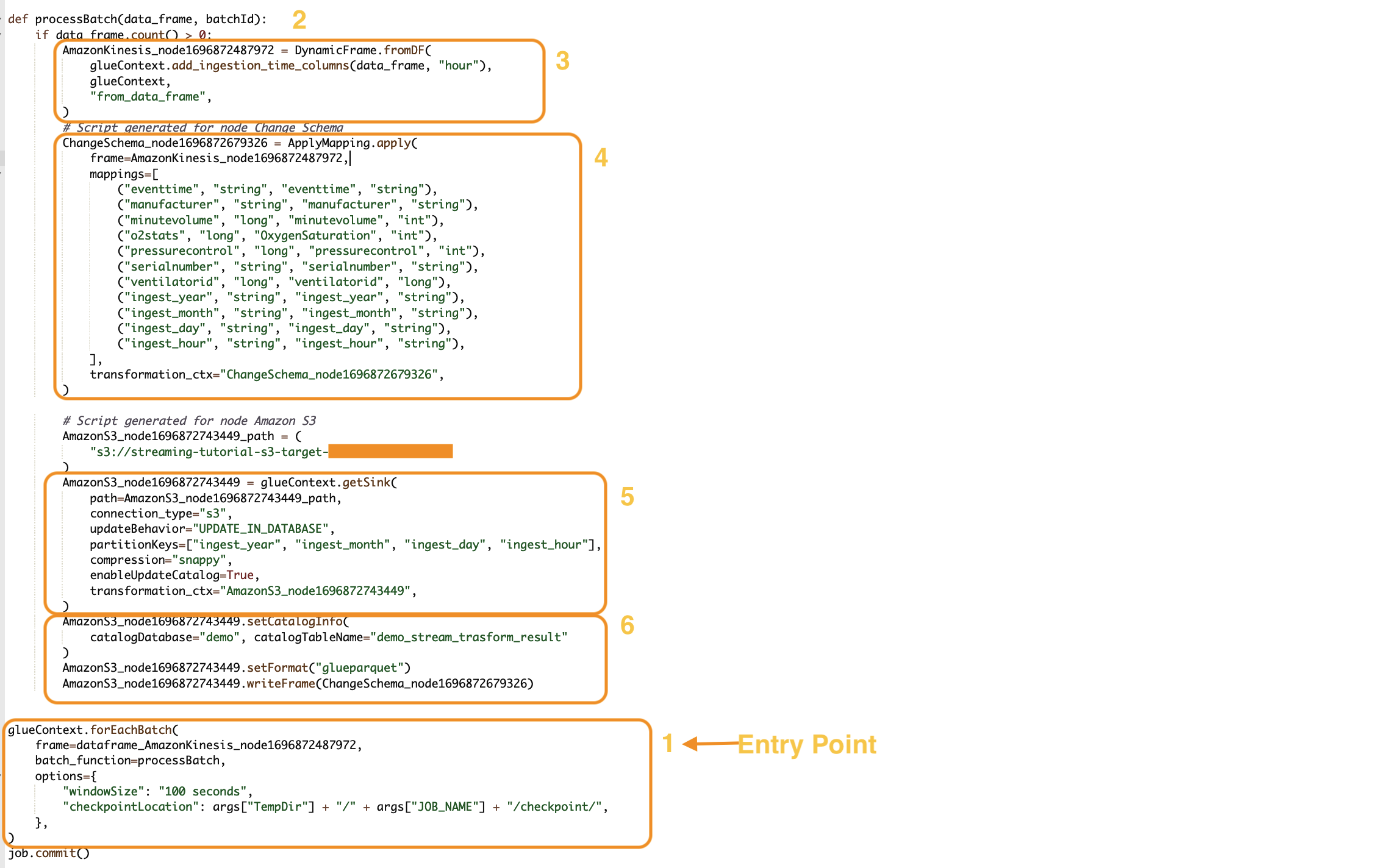Amazon Glue Streaming concepts
The following sections provide information on concepts of Amazon Glue Streaming.
Anatomy of a Amazon Glue streaming job
Amazon Glue streaming jobs operate on the Spark streaming paradigm and leverage structured streaming from the Spark framework. Streaming jobs constantly poll on the streaming data source, at a specific interval of time, to fetch records as micro batches. The following sections examine the different parts of a Amazon Glue streaming job.

forEachBatch
The forEachBatch method is the entry point of a Amazon Glue streaming job run.
Amazon Glue streaming jobs uses the forEachBatch method to poll data functioning
like an iterator that remains active during the lifecycle of the streaming job
and regularly polls the streaming source for new data and processes the latest data in micro batches.
glueContext.forEachBatch( frame=dataFrame_AmazonKinesis_node1696872487972, batch_function=processBatch, options={ "windowSize": "100 seconds", "checkpointLocation": args["TempDir"] + "/" + args["JOB_NAME"] + "/checkpoint/", }, )
Configure the frame property of forEachBatch to specify a streaming source.
In this example, the source node that you created in the blank canvas during job creation is populated
with the default DataFrame of the job. Set the batch_function property as the
function that you decide to invoke for each micro batch operation. You must define a
function to handle the batch transformation on the incoming data.
Source
In the first step of the processBatch function, the program verifies the record count of
the DataFrame that you defined as frame property of forEachBatch. The program
appends an ingestion time stamp to a non-empty DataFrame. The data_frame.count()>0 clause
determines whether the latest micro batch is not empty and is ready for further processing.
def processBatch(data_frame, batchId): if data_frame.count() >0: AmazonKinesis_node1696872487972 = DynamicFrame.fromDF( glueContext.add_ingestion_time_columns(data_frame, "hour"), glueContext, "from_data_frame", )
Mapping
The next section of the program is to apply mapping. The Mapping.apply method on a
spark DataFrame allows you to define transformation rule around data elements. Typically you can rename,
change the data type, or apply a custom function on the source data column and map those to the
target columns.
#Script generated for node ChangeSchema ChangeSchema_node16986872679326 = ApplyMapping.apply( frame = AmazonKinesis_node1696872487972, mappings = [ ("eventtime", "string", "eventtime", "string"), ("manufacturer", "string", "manufacturer", "string"), ("minutevolume", "long", "minutevolume", "int"), ("o2stats", "long", "OxygenSaturation", "int"), ("pressurecontrol", "long", "pressurecontrol", "int"), ("serialnumber", "string", "serialnumber", "string"), ("ventilatorid", "long", "ventilatorid", "long"), ("ingest_year", "string", "ingest_year", "string"), ("ingest_month", "string", "ingest_month", "string"), ("ingest_day", "string", "ingest_day", "string"), ("ingest_hour", "string", "ingest_hour", "string"), ], transformation_ctx="ChangeSchema_node16986872679326", ) )
Sink
In this section, the incoming data set from the streaming source are stored at a target location.
In this example we will write the data to an Amazon S3 location. The AmazonS3_node_path property
details is pre-populated as determined by the settings you used during job creation from the canvas.
You can set the updateBehavior based on your use case and decide to either Not update
the data catalog table, or Create data catalog and update data catalog schema on subsequent runs, or
create a catalog table and not update the schema definition on subsequent runs.
The partitionKeys property defines the storage partition option. The default behavior
is to partition the data per the ingestion_time_columns that was made available in the
source section. The compression property allows you to set the compression algorithm
to be applied during target write. You have options to set Snappy, LZO, or GZIP as the compression
technique. The enableUpdateCatalog property controls whether the Amazon Glue
catalog table needs to be updated. Available options for this property are True or
False.
#Script generated for node Amazon S3 AmazonS3_node1696872743449 = glueContext.getSink( path = AmazonS3_node1696872743449_path, connection_type = "s3", updateBehavior = "UPDATE_IN_DATABASE", partitionKeys = ["ingest_year", "ingest_month", "ingest_day", "ingest_hour"], compression = "snappy", enableUpdateCatalog = True, transformation_ctx = "AmazonS3_node1696872743449", )
Amazon Glue Catalog sink
This section of the job controls the Amazon Glue catalog table update behavior.
Set catalogDatabase and catalogTableName property per your Amazon Glue
Catalog database name and the table name associated with the Amazon Glue job that you are
designing. You can define the file format of the target data via the setFormat property.
For this example we will store the data in parquet format.
Once you set up and run the Amazon Glue streaming job referring this tutorial, the streaming data produced at Amazon Kinesis Data Streams will be stored at the Amazon S3 location in a parquet format with snappy compression. On successful runs of the streaming job you will able to query the data through Amazon Athena.
AmazonS3_node1696872743449 = setCatalogInfo( catalogDatabase = "demo", catalogTableName = "demo_stream_transform_result" ) AmazonS3_node1696872743449.setFormat("glueparquet") AmazonS3_node1696872743449.writeFormat("ChangeSchema_node16986872679326") )